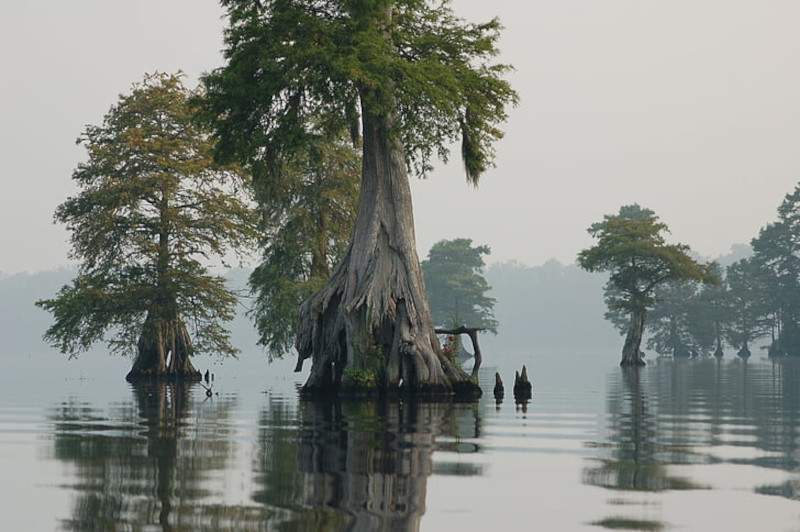
Great Dismal Swamp Facts
- This incredible product of natural forces most frequently goes by the descriptive, if not wholly accurate, common name of the Great Dismal Swamp. Presently, the intriguing wonder of Nature has no other broadly accepted english language title.
- The appellation of dismal is somewhat misleading, however. Most people believe it pertains to the atmosphere of the location. The truth is actually quite different. Early settlers in the region refered to standing water in any such region by this term.
- Archaeological evidence indicates that Indigenous Peoples knew of and inhabited this remarkable site for at least 13,000 years prior to the arrival of outside Europeans. At the time of their arrival, the Powhatan empire extended to its northern edge.
- It’s not currently known who the first person other than a native of the region to see the formation was, or when this occurred. History does record, though, that William Drummond became the first non-native to discover the lake at its center, in 1665.
- Though not as extensive as it once was, the Great Dismal Swamp remains a truly extraordinary creation of Nature. It now enjoys a protected status in the country it sits in. In 1974, the entire site was named the Great Dismal Swamp National Wildlife Refuge.
Related Articles
Great Dismal Swamp Physical Description
The Great Dismal Swamp represents an incredible creation of nature that unfailingly evokes strong emotions among those who venture to see it. Though it does so for a variety of reasons, the sheer physical dimensions its boasts understandably count as one.
Some experts have estimated that this marvel of creation once encompassed a staggering 1,544 sq mi (4,000 sq km). Sadly, however, the feature’s much smaller than that today. Currently, it covers a total area measuring approximately 274 sq mi (710 sq km).
This impressive setting comes primarily characterized by comparatively flat terrain. It additionally boasts mostly low-lying areas covered by water, marshes, and peat bogs. The elevation of the site further remains generally very low, often only a few feet above sea level.
The Great Dismal Swamp also lies crisscrossed by numerous waterways, including rivers, streams, and creeks. Its most notable water feature, however, is Lake Drummond. That’s a somewhat shallow freshwater lake located very near the center of the extensive swamp.
The water also presents as dark and tea-colored due to tannins leached from the decaying vegetation. A mystery persists pertaining to the water itself, though. Its origin remains a puzzle, given that no obvious network of natural water inflow, other than rain, exists
Great Dismal Swamp Location, Formation, and Ecology
The distinctively named Great Dismal Swamp formed in a regon of the globe already well known for its abundance of natural marvels. The exact location of the formation might surprise you, though. That’s because it sits within the boundaries of a part of North America.
There, it resides along the eastern coast of the United States. Approximately 87.5% of its area falls within the confines of the state of Virginia. The remainder lies inside the state borders of North Carolina. Amazingly, the entire site lies in a coastal plain region near the sea!
This site came into existence through a combination of events. Evidence indicates that the process began around 18,000 years ago, during the last ice age. At that time, retreating glaciers caused sea levels to rise, flooding the area, and creating a shallow, marshy basin.
Over time, organic matter, mainly peat, accumulated in the basin as vegetation grew, died, and decomposed. The slow decomposition rate of organic material in the conditions of the swamp led to the formation of thick layers of peat, adding to its typically spongy terrain.
The magnficent Great Dismal Swamp constitutes one of the largest remaining regions of wetlands in its part of the world. As such, it plays a pivotal role in its environment. It’s primarily composed of areas of freshwater peat swamp forests, marshes, and streams.
These understandably support a wide range of both flora and fauna. Main plant species include Atlantic white cedar, black gum, red maple, bald cypress, and multiple types of shrubs and ferns. The swamp is also known for its extensive stands of sphagnum moss.
This marvel also provides habitat for a wide array of fauna, including mammals, birds, reptiles, amphibians, and fish. Species such as black bear, white-tailed deer, bobcat, otter, and various bird species live here. It’s also an important nesting area for migratory birds.
Features Sharing Its Region
Check out our other articles on 5 Fabulous Flora of Germany, Eurasian Brown Bear, Vikos Gorge, Red Wood Ant, Royal poinciana, Southern Stingray, Little Auk, Leatherback Sea Turtle
